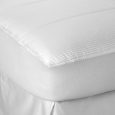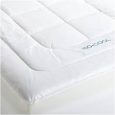Bedding, also known as bedclothes or bed linen, is the materials laid above the mattress of a bed for hygiene, warmth, protection of the mattress, and decorative effect. Bedding is the removable and washable portion of a human sleeping environment. Multiple sets of bedding for each bed are often washed in rotation and/or changed seasonally to improve sleep comfort at varying room temperatures. Most standardised measurements for bedding are rectangular, but there are also some square-shaped sizes, which allows the user to put on bedding without having to consider its lengthwise orientation (i.e. a 220 cm × 220 cm (87 in × 87 in) duvet).
In American English, the word bedding generally does not include the mattress, bed frame, or bed base (such as box-spring), while in British English it does. In Australian, South African and New Zealand English, bedding is often called manchester, especially in shops.
A set of bedding usually consists of a flat or fitted bed sheet that covers the mattress; a flat top sheet; either a blanket, quilt, or duvet, sometimes with a duvet cover, which can replace or be used in addition to the top sheet; and a number of pillows with pillowcases, also referred to as pillow shams. (See § Terminology for more info on all these terms.) Additional blankets, etc. may be added to ensure the necessary insulation in cold sleeping areas. A common practice for children and some adults is to decorate a bed with plush stuffed animals, dolls, and other soft toys. These are not included under the designation of bedding, although they may provide additional warmth to the sleeper.
Lightweight white, solid-color or printed plain weave, satin weave, or flannel cotton or cotton/polyester blends are the most common types of sheeting, although linen and silk may also be used, including in combination. Goose or duck down and other feathers are frequently used as a warm and lightweight filling in duvets, comforters and quilts. But such fill can protrude in part even from tightly-woven fabric, and be an irritant for many people, particularly those with allergies. Natural and synthetic down alternatives are marketed. Cotton, wool or polyester batting is commonly used as fill in quilts and down alternative comforters. These are less expensive and more easily laundered than natural down or feathers. Synthetic fibers are best in the form of thermofused (where fibers cross) batting. Thick-woven or knitted wool, cotton, acrylic or other microfiber synthetics, or blends of these, are typically used for blankets.
Around 3400 BC Egyptian pharaohs had their beds moved off the ground and slept on a raised surface. Bed linen was widely evolved in Egypt. It was seen as a symbol of light and purity, as well as a symbol of prosperity. The Egyptian mummies were often wrapped in bed linen.
Roman Empire mattresses were stuffed with wool, feather, reeds or hay. The beds were decorated with paint, bronze, silver, jewels and gold.
In Japan, mattress types were stuffed with cotton and rolled up for storage during the day.
During the Renaissance, mattresses were stuffed with straw and feathers and then covered with silks, velvets or satin material.
In the 18th century, Europeans began to use bed frames made from cast iron, and mattresses that were made of cotton.
In the 19th century the bed spring was invented, also called the box spring.
In the 20th century United States, consumers bought the inner spring mattress, followed in the 1960s by the water bed (originating on the West Coast), and adoption of Japanese-style futons, air mattresses, and foam rubber mattresses and pillows.
Bedding sizes are made with consideration of the dimensions of the bed and mattress for which it is to be used. Bed sizes vary around the world, with countries having their own standards and terminology.
Mattress sizes can be categorized by their country of sale:
In Spain, standard mattress widths are 90 cm (35″), 105 cm (41″), 135 cm (53″), 150 cm (59″), 180 cm (71″) and standard lengths 190 cm (75″) and 200 cm (79″). Sizes are not named but are referred to by their dimensions in cm.
In Denmark standard sizes follow below table
In Ukraine and other Post-Soviet countries, bed measurements are not named but can be linked to standard bedding names. Single bedding sets are not popular, Semi-Double bedding actually used for Single bed.
80 cm × 200 cm (31 in × 79 in)
90 cm × 190 cm (35 in × 75 in)
90 cm × 200 cm (35 in × 79 in)
(Semi-Double) bed
120 cm × 200 cm (47 in × 79 in)
140 cm × 200 cm (55 in × 79 in)
160 cm × 190 cm (63 in × 75 in)
160 cm × 200 cm (63 in × 79 in)
180 cm × 190 cm (71 in × 75 in)
180 cm × 200 cm (71 in × 79 in)
Fitted sheets are not popular as there is a huge variety of bed sizes. Usually they are +20 or +25 cm to cover a mattress. Flat sheet size is also may vary depending on vendor. Sleeping pillows covers are usually 50 × 70 cm, 60 × 60 or 70 × 70 cm. “Euro” prefix is refereed to Western Europe but actually the measurements doesn’t match ones for the European countries. “Euro Max” matches “King” size. Bedding measurements:
Standard Japanese bedding sizes are described in the standard JIS S 1102:2017 Beds for domestic use by the Japanese Standards Association.



